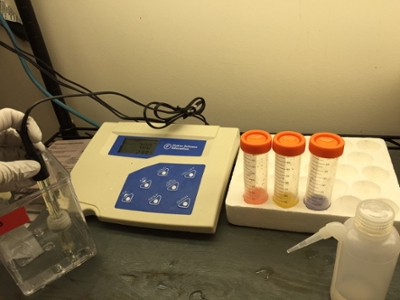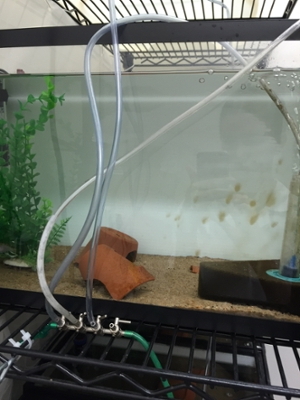PSF: A Day in the Fish Lab

Enter my lair... This is the door to one of the rooms my tanks were in, with a daily tasks list so I don't forget anything!
As part of the President’s Summer Fellowship program, I spent my summer in a lab at the University of Alberta in Edmonton, AB, Canada. My project there was to breed adult fish and raise the fry in different pH conditions (neutral and acidic) in order to investigate the mechanisms of this species’ pH-influenced sex determination. I took fry from each family for DNA and RNA samples three times during the first two months of development to produce a timecourse view of the changes that take place in the young fish. While working on my own project, I also helped take care of the fish stocks and fish for other experiments in the lab.
 I’ve been exchanging letters with a friend who is working on a farm this summer, and in his last letter he said something that made me think: that every job has its unusual tasks, which other people wouldn’t necessarily know about or think of. His comment made me think about all of the things I do every day, which I knew very little about before I started working in a research lab studying fish. With that in mind, here’s a brief “day in the life” of a fish lab:
I’ve been exchanging letters with a friend who is working on a farm this summer, and in his last letter he said something that made me think: that every job has its unusual tasks, which other people wouldn’t necessarily know about or think of. His comment made me think about all of the things I do every day, which I knew very little about before I started working in a research lab studying fish. With that in mind, here’s a brief “day in the life” of a fish lab:
FEEDING
Obviously, the fish have to be fed every day. There are a lot of students working in the lab, so different people feed on different days of the week. We give them flake food, just like you would feed to a pet fish, but we also have special food for the fry to help them grow. This means keeping track of which tanks have fry - at any given time, there might be babies in as many as 20 tanks! (There are around 110 fish tanks total.) Several experiments in the lab, including mine, have to do with raising fry in different conditions, so we’re excited to have so many fry. We keep a list of tanks with fry on a blackboard in the fishroom.
CHECKING BUBBLERS
In order to keep the fishes’ water oxygenated, there has to be an air bubbler in every tank. For a lab with over a hundred tanks, that means we have toair blowers scattered all over the lab, and “gang valves” which split each air tube so that it can be sent into several tanks. It’s amazing how much rubber tubing that takes! We check the bubblers daily to make sure they’re working. If an air system develops a leak, it can be hard to find - one day, I spent three hours systematically replacing each part (air blower, hose from blower to gang valve, gang valve itself, each hose from gang valve to bubbler, and airstone diffuser inside each bubbler) of one of my air systems to figure out where the leak was before I finally figured out that the gang valve was the problem! My mentor, Pete, taught me a good trick: Immerse the gang valve in water, then look for a stream of air bubbles. It’s like the inverse version of how we detect leaks in tanks and water filters - by looking for drips!
READING PH
For my experiment, I’m raising fish in different pH conditions (some acidic, some neutral) in order to learn how and when pH impacts sex determination. I need to be sure that my tanks have the right conditions, so I check the pH every day. I have a digital pH meter for this, which is a lot more precise than pH paper! I calibrate the meter daily using color-coded buffer solutions at pH 4, 7, and 10.
READING TEMPERATURES
Another of the experiments happening in the lab has to do with temperature. We have thermometers in those tanks which need to be checked every day. I also check the temperature of my pH experiment tanks to make sure they’re all in about the same range. That way, I know that the only difference between my acidic and neutral tanks is the pH.
TANK CLEANING & WATER CHANGES
 Hands up if you know how to use a siphon! I didn’t, until I started working in a fish lab, but now I know four different ways to start a siphon. For those who aren’t familiar with the concept, it’s a way to suck water out of a tank using just the force of gravity. You get the siphon started by filling the tube with water. There are a couple ways in which you can accomplish this, but the one thing you should NEVER do in a fish lab is mouth siphoning, where you use your mouth to suck water into the tube (gross!) Instead, we do things like dipping the siphon into a barrel of water to fill it, or using a hand pump.
Hands up if you know how to use a siphon! I didn’t, until I started working in a fish lab, but now I know four different ways to start a siphon. For those who aren’t familiar with the concept, it’s a way to suck water out of a tank using just the force of gravity. You get the siphon started by filling the tube with water. There are a couple ways in which you can accomplish this, but the one thing you should NEVER do in a fish lab is mouth siphoning, where you use your mouth to suck water into the tube (gross!) Instead, we do things like dipping the siphon into a barrel of water to fill it, or using a hand pump.
After I siphon about a third of the water out of a tank, I’ll refill it with fresh water. I use water changes to maintain the pH of my neutral tanks, and I also do water changes to keep tanks clean. If I’m cleaning a tank, I’ll scrub algae off the sides with a scraper before siphoning.
